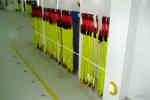Step 2 of 3•5 minutes read
Inspection of Cargo Securing Equipment
Since all cargo securing equipment is subjected to wear and tear, its condition must continuously be checked regarding deficiency. If faulty equipment is being used, it might fail and cause damage to the cargo or the vessel or endanger the safety of the crew. Although scheduled inspections should be carried out following the vessel CSM, the most efficient way of ensuring that the equipment is kept in a sound condition is to always examine it as it is being used during loading or restowed after unloading. This can be achieved by performing a visual inspection and a test of the basic functionality of the equipment.
Damaged portable cargo securing equipment should, without delay, be rejected and isolated from intact equipment. Damaged fixed equipment, such as D-rings and lashing sockets, shall be replaced by equivalent fittings at the earliest opportunity and marked as defective so it is not inadvertently used.

Lashings neatly stored
Maintenance of Cargo Securing Equipment
Schedules and instructions for maintaining the cargo securing equipment are also found in the vessel CSM. The most important maintenance tasks on board are to grease movable parts, such as ratchets & turnbuckle threads, as well as replace damaged lashing fittings in the deck. General guidance on how to inspect and maintain both portable and fixed equipment is presented in the next pages of this section.

Securing equipment must be inspected regularly
Web Lashings
For equipment based on webbings such as; web lashes, roll lashes, car lashes and slings, the following instructions apply.
Inspection of web lashings starts with thoroughly examining the webbing itself, looking for cuts to the edges exceeding 10% of the width, break or cut damages across the lashing that has broken most surface threads, or signs of general wear and tear.
Age and dirt will also cause web lashings to lose some of their strength. For this reason, lashings for which it is hard to determine the original colour should be rejected.
Any webbing that has come in contact with alkaline products might be severely damaged due to chemical degradation and should be scrapped even if it looks sound and proper.

Web lashings that should be sorted out and scrapped
The tensioning device should also be visually examined, and its basic functionality should be tested. Make a thorough examination of the gear mechanism, the locking plate, and the bolt or pin fixing the webbing. You should look for any wear and tear, cracks, or missing parts. Rotate the handle a few times to ensure the gear mechanism runs smoothly.
Maintaining web lashings is mainly a matter of greasing moveable parts. Place a few drops of oil where the shaft passes through the handle and the webbing fixture. Also, place a few drops of oil in the area where the locking device is sliding in a groove through the webbing fixture. Any equipment with abnormal wear and tear or other damage must be rejected and sent ashore for repair or disposal.

Inspection of web lashings starts with a through examination
Chain Lashings
Inspection of chain lashings starts with thoroughly examining the chain links, evaluating link elongation, and determining if the link diameter has been decreased in any part.
Any chain with an elongation above 5% or links with more than a 20% decrease in diameter shall be rejected and separated from intact equipment. Links bent or otherwise deformed should be replaced, or the whole chain should be rejected.
During an inspection of levers and hooks, attention should be paid to cracks, missing parts, and abnormal wear and tear.
Maintaining chain lashings is mainly a matter of greasing moveable parts in turnbuckles or speed lash tensioners.
Jacks
During an inspection of jacks, attention should be paid to the supporting structure and the thread on the jack. Look for cracks, especially in areas on and around welds, as these are normally the weak parts. The thread should be visually inspected for damage and missing ridges. Jacks with damaged threads or visual cracks should be rejected and sent ashore for repair or demolition. Maintenance of jacks is done by greasing the thread and placing a few drops of oil in the bearing for the rotating head.

Look at the supporting structure and thread on the jack
Fixed Cargo Securing Equipment
When examining fixed cargo securing equipment, the structure to which the device is attached should be examined for deformation or fractures. If any visual damage is found, the structure is to be repaired.
The material of the device itself should then be examined for excess wear or fractures, and if any are found, the device should be replaced with one of at least the same strength. Welding of the device to the structure should be carried out by approved personnel following appropriate welding practices.

Lashing holes, crinkle bars and D-rings
Summary
All cargo securing material and equipment used on board shall have a certificate that shows that it has been tested for the intended loads.
All cargo securing material shall be inspected at regular intervals. The Chief Officer must record these inspections and maintenance of the cargo securing equipment. Before equipment is used for cargo securing, it shall also be visually inspected. If any equipment is found damaged, it shall be set aside in isolation onboard, so it is not mixed with functional equipment. The damaged equipment shall be repaired or taken ashore and replaced with new equipment.
Depending on which material the cargo securing material is made of; textile, chain, wire, steel, etc. different types of inspection and testing will be required.